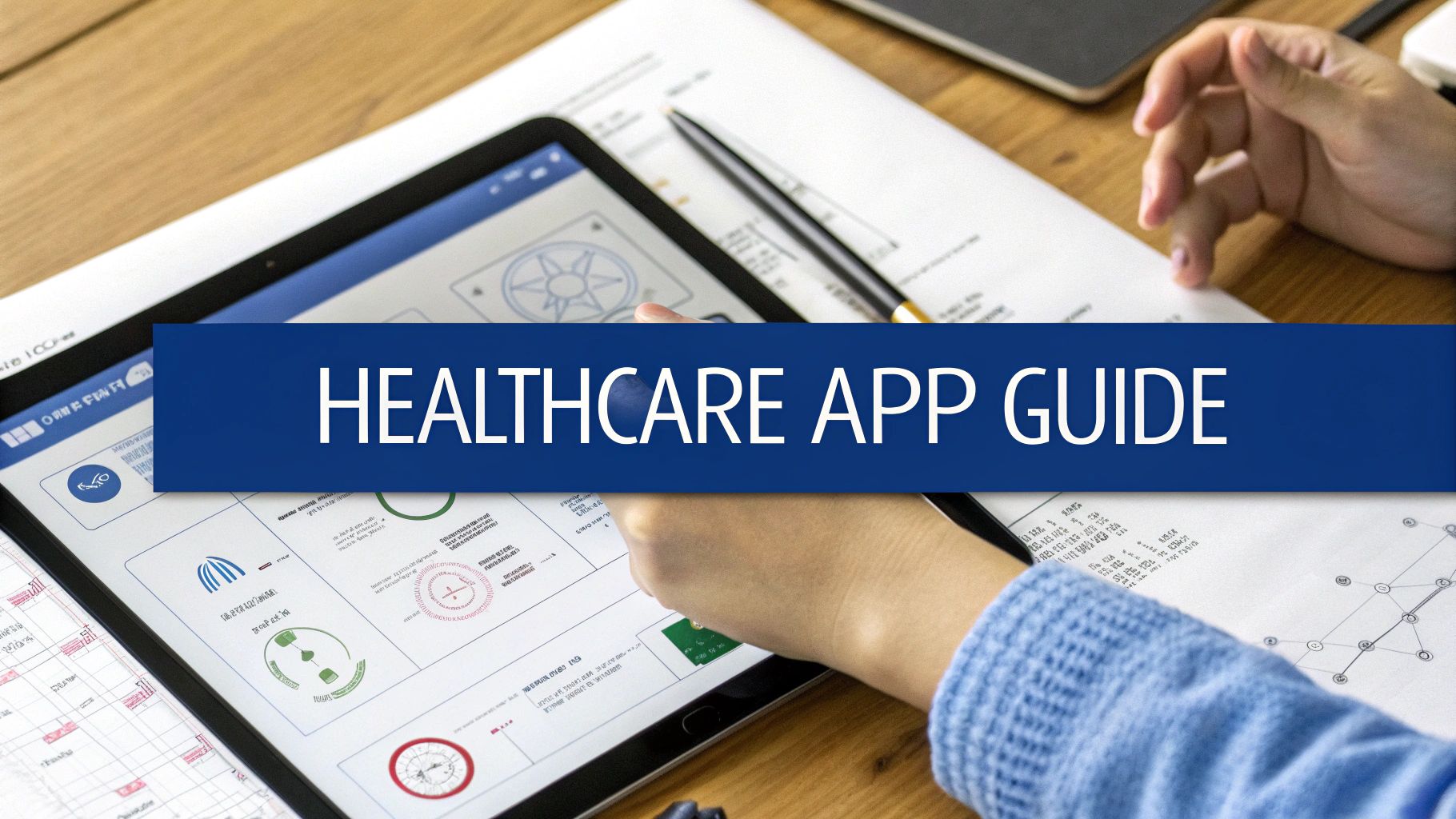Think of a technology roadmap template as your strategic playbook for every tech initiative. It's the essential document that connects your technology efforts directly to your company's biggest goals. More than just a list of projects, it’s a communication tool that clearly explains where you're headed and, most importantly, why.
This alignment is crucial. It prevents costly missteps and ensures every dollar spent on tech is actively pushing the business forward.
Unlocking Strategic Alignment with a Technology Roadmap
At its heart, a technology roadmap is the bridge between your company's high-level vision and the everyday work of your tech teams. Without one, you get silos. And silos lead to duplicated work, clashing systems, and a whole lot of wasted money.
I've seen it happen time and again. A mid-sized e-commerce company is growing fast. The sales team, on their own, buys a new CRM. Marketing, in a separate move, rolls out a new analytics platform. Meanwhile, the IT department starts a massive server upgrade.
Each of these decisions makes sense in a vacuum, but without a unifying roadmap, disaster strikes. The new CRM can't talk to the analytics platform, and the new servers aren't powerful enough to handle the data from either system.
This isn't some rare, cautionary tale. A company without a clear roadmap can easily burn through a six-figure sum on a tech stack that simply can't scale. A coordinated plan would have caught this mistake before a single dime was spent.
The True Purpose of Roadmapping
A solid technology roadmap does more than just list features and deadlines. It’s fundamentally about creating clarity and getting everyone on the same page.
- Securing Stakeholder Buy-In: It tells a clear, visual story that executives and investors can actually get behind. This shared vision makes it infinitely easier to get the budget and resources you need.
- Improving Resource Management: By laying out priorities and dependencies, you can put your best people—and your budget—on the projects that will make the biggest difference to the bottom line.
- Enhancing Cross-Functional Collaboration: A roadmap forces conversations between teams that might not otherwise talk. When marketing can see the platform migration IT has planned, they can time their campaign launches to avoid chaos.
- Guiding Prioritization and Decision-Making: It becomes your "North Star." When a new, shiny tech idea pops up, you can hold it up against the roadmap and make a smart decision instead of an impulsive one.
From Strategy to Execution
The real magic of a technology roadmap is how it turns big-picture strategy into a concrete plan. Using a good template is a game-changer for IT managers and tech leaders, helping them manage initiatives and track progress in a structured way. You can clearly visualize timelines, assign owners, and see status updates at a glance.
This structure is what turns abstract goals into real-world action. To get a feel for how this plays out in a complex initiative, check out the detailed breakdown in A Practical Digital Transformation Roadmap.
Using a template isn't just about planning what you're going to build. It’s about building a shared understanding of why it all matters.
Adopting a template-driven approach to technology roadmapping provides a number of clear advantages. Here's a quick summary of the biggest impacts you can expect.
Key Benefits of Using a Technology Roadmap Template
| Benefit Category | Description of Impact |
|---|---|
| Strategic Alignment | Ensures all tech projects directly support and advance overarching business objectives, preventing siloed or misaligned work. |
| Communication & Transparency | Creates a single source of truth that clearly communicates priorities, timelines, and dependencies to all stakeholders, from executives to engineers. |
| Resource Optimization | Helps in allocating budgets, personnel, and time more effectively by prioritizing high-impact initiatives and identifying potential resource conflicts early. |
| Improved Decision-Making | Provides a strategic framework for evaluating new ideas and requests, enabling data-informed decisions over reactive ones. |
| Risk Mitigation | Surfaces potential dependencies, technical hurdles, and scheduling conflicts in advance, allowing teams to proactively address risks before they become major problems. |
Ultimately, a well-defined roadmap template ensures that every piece of technology you implement contributes directly and measurably to the company's long-term success.
The Essential Components of a Great Technology Roadmap

A powerful technology roadmap is so much more than a list of projects; it’s a strategic story. Each piece plays a specific role in explaining where your technology is headed and, more importantly, why it matters. To build a roadmap that people actually use, you have to look past the template and get to the heart of what each element is trying to accomplish.
When you get this right, your plan transforms from a static document into a living guide. It draws a crystal-clear line from the high-level business vision all the way down to the specific, day-to-day initiatives that make it happen.
Strategic Goals and Initiatives
Let’s start with the absolute foundation: the explicit link between what you’re building and the company’s strategic goals. This isn't just a nice-to-have; it's the core that justifies every single decision. Without it, your roadmap is just a tech wish list with no real business purpose.
For example, a business goal might be to "Increase customer retention by 15% in the next fiscal year." The corresponding initiative on your roadmap shouldn't be "Upgrade database." It should be "Implement a new customer data platform to enable personalized user experiences." This immediately shows how a tech project directly serves a critical business outcome.
A solid technology roadmap also has to bake in a plan for managing technical debt. If you ignore it, you're just setting yourself up for slower development cycles and ballooning maintenance costs down the road.
Clear Timelines and Milestones
While roadmaps need to be flexible, they can't be a free-for-all. Timelines, often broken down by quarters or even months, give everyone a high-level view of when initiatives are expected to kick off and wrap up. The point isn't to set rigid, unbreakable deadlines, but to sequence the work in a way that makes sense.
Within those timelines, key milestones are your signposts. They mark significant achievements or decision points, like "Beta launch of new mobile app" or "Complete data center migration." These markers make progress feel real for stakeholders and are fantastic for keeping the team aligned and motivated.
Swimlanes for Teams and Products
Clarity is king, and when it comes to visual organization, swimlanes are your best friend. These are the horizontal rows that slice up the roadmap, assigning different initiatives to specific teams, departments, or product lines.
Think of a roadmap with a few distinct swimlanes:
- Infrastructure Team: Handling server upgrades and cloud migrations.
- Product Team A (Mobile App): Focused on new feature development and UX improvements.
- Data & Analytics Team: Working on building out a new business intelligence dashboard.
This structure instantly tells you who owns what, cutting through confusion and—critically—shining a spotlight on any cross-team dependencies.
Dependencies and Risk Assessment
This is where I’ve seen countless roadmaps either succeed or fail spectacularily. Dependencies are those crucial links where one project can't start (or finish) until another one is done. Miss one of these, and you can set off a massive domino effect.
I once worked with a SaaS company that had a big new app launch planned, but it was entirely dependent on a database upgrade. The app team was crushing it, but the infrastructure team's upgrade got held up by a vendor problem. Because that dependency wasn't clearly mapped and tracked, the app was ready to go but couldn't launch. We faced a three-month delay and a lot of frustrated people.
Mapping your dependencies forces those vital conversations between teams early on. If you're coordinating with external partners, our guide on the software vendor onboarding roadmap (https://www.cleffex.com/blog/software-vendor-onboarding-roadmap/) has some practical steps that can help.
Resource Allocation and Budgeting
Finally, a roadmap has to be grounded in reality. The resource allocation piece outlines the people, budget, and tools you actually have to execute the plan. It's here that you answer the tough questions: "Do we have enough developers for this?" and "Is the budget for the new cloud services actually approved?"
Baking this information directly into your roadmap template forces you to make realistic commitments. It’s a sanity check that ensures your ambitious plans are actually achievable within your company's constraints and is crucial for getting executive buy-in. In fact, studies show that over 70% of high-performing tech companies use formal roadmaps to align their investments. They often use tools like Gantt charts to visualize dependencies, which can help reduce project delays by up to 25%.
Building Your Technology Roadmap from Scratch
Alright, let's get down to brass tacks. Moving from a collection of great ideas to a solid, actionable plan is where the real work of building a technology roadmap begins. This isn't just about plugging tasks into a template; it's about steering strategic conversations and making deliberate choices that will define your company's trajectory. And it all starts with people, not code.
The quality of your roadmap is a direct reflection of the quality of your inputs. Sure, you could send out a survey, but I've found that usually just gets you a laundry list of feature requests, not a clear picture of what the business actually needs. To really get to the heart of the matter, you have to run effective stakeholder workshops.
Uncovering True Business Needs Through Workshops
A well-run workshop is designed to get past the surface-level "wants" and dig into the real problems people are facing. Your goal is to pivot the conversation from "We need a new dashboard" to "We can't get sales data fast enough to make timely decisions." That simple shift in perspective is what separates a roadmap that just adds features from one that delivers genuine business value.
Here are a few ways I’ve seen this work really well in practice:
- Problem Brainstorming: Go around the room and ask each department to list their top three operational headaches that technology could help fix. This immediately focuses the conversation on pain points, not pet projects.
- "What If" Scenarios: Try posing open-ended questions like, "What if you could automate the most time-consuming part of your day?" This gets people thinking creatively about outcomes instead of getting bogged down in specific solutions.
- Journey Mapping: Ask a team to map out a current process that's clunky or frustrating. Actually drawing it out on a whiteboard often uncovers hidden bottlenecks and opportunities that would never show up on a simple request list.
Getting everyone in a room together does more than just generate better ideas—it builds early buy-in. When the head of sales hears firsthand about the data challenges marketing is dealing with, they start to see the bigger picture. That shared understanding makes the tough prioritization talks down the road go a whole lot smoother.
From Vision to Actionable Projects
Once you've gathered all this rich input, it's time to translate it into your roadmap template. This is where you connect that high-level strategic vision to tangible, real-world projects.
Let’s walk through a real-world scenario. I worked with a mid-sized e-commerce company—we'll call them "UrbanBloom"—who needed to migrate off their clunky, monolithic platform.
First, we pinned down their core strategic vision: "To provide a seamless, personalized shopping experience that can scale to support a 50% increase in traffic during peak seasons." This became our North Star for every decision that followed.
With that vision in place, we broke it down into specific, measurable goals:
- Reduce page load time by 40%.
- Increase customer conversion rates by 10%.
- Enable A/B testing on all key product pages.
- Decrease infrastructure maintenance hours by 25%.
These goals gave us the framework to define the actual initiatives. Instead of a vague project like "Migrate Platform," their roadmap featured distinct projects like "Implement Headless CMS," "Deploy Cloud-Native Infrastructure," and "Integrate New Personalization Engine." We made sure every single project could be traced directly back to one or more of those strategic goals. It creates a crystal-clear line of sight from the daily grind to the company's big-picture vision.
Navigating Priorities with an Impact vs. Effort Matrix
Let's be real: no company has unlimited resources. UrbanBloom was no different. The marketing team was clamoring for the new personalization engine, while the engineering lead was adamant about upgrading the infrastructure to fix stability issues. This is exactly where a structured prioritization method saves the day.
We pulled out a simple but incredibly powerful tool: the impact vs. effort matrix.
This framework forces you to evaluate each potential project on two dimensions: the potential business value it will deliver (impact) and the amount of time, money, and resources it will consume (effort). It’s a crucial step in moving from a wish list to a realistic, high-value plan.
We plotted every initiative on a four-quadrant grid:
- High Impact, Low Effort (Quick Wins): These are the no-brainers. For UrbanBloom, this included a small project to optimize their checkout flow.
- High Impact, High Effort (Major Projects): These are the big, strategic bets. The infrastructure upgrade and the personalization engine both landed here.
- Low Impact, Low Effort (Fill-ins): Small tasks to tackle if time permits but aren't critical.
- Low Impact, High Effort (Money Pits): These are the projects you need to run away from.
The matrix gave us an objective visual that turned a subjective debate into a data-driven conversation. It became obvious that while the personalization engine was high-impact, the infrastructure upgrade was a foundational dependency. Without it, nothing else could be built reliably. The discussion shifted from opinions to strategic sequencing. Everyone agreed to tackle the infrastructure first, teeing up the personalization engine for the following quarter.
This structured process helped UrbanBloom build a realistic, defensible technology roadmap. It turned what could have been a contentious planning session into a collaborative exercise that got the entire leadership team genuinely excited and confident about the path forward.
Visualizing your roadmap's key milestones is essential for keeping everyone on the same page.

A visual like this makes it easy for stakeholders at all levels to quickly grasp the sequence of major deliverables and see exactly how they contribute to the overall strategy.
Finding the Right Technology Roadmap Tool for Your Team
Picking the right tool for your technology roadmap is a bigger deal than you might think. It directly shapes how your team uses, shares, and keeps the plan alive. You could just use a spreadsheet, and many teams do start there. But the right software can elevate your roadmap from a static document that collects digital dust to a dynamic, collaborative hub for strategic planning.
The choice usually boils down to one of three paths, each with its own set of trade-offs. What works best will depend on your team's size, the complexity of your projects, and of course, your budget. Let's cut through the noise and look at what really matters: cost, ease of use, collaboration features, and how well it plays with your other tools.
Starting with Spreadsheets
For a small team or a brand-new project, kicking things off with a spreadsheet like Google Sheets or Excel is often the path of least resistance. They’re free, everyone knows how to use them, and you can mock up a timeline and color-code priorities in minutes. No learning curve, no new software to buy.
But that initial simplicity has a shelf life. As your plans get more complex, spreadsheets become a real headache to manage. Version control turns into a guessing game ("Is this the final-FINAL version?"), collaboration is clunky at best, and there’s no clean way to link dependencies or sync with your development tools.
I’ve seen this happen firsthand. A spreadsheet roadmap becomes more trouble than it’s worth the moment you spend more time fixing formatting and chasing down the “latest version” than you do discussing the actual strategy. It’s a clear sign you’ve outgrown the tool.
Using Existing Project Management Tools
The next logical step for many teams is to see what they can do with the project management software they already have in their back pocket—think Asana, Jira, or Trello. This is a huge improvement over spreadsheets. You get much better collaboration, clear task assignments, and established workflows. Plus, keeping your roadmap in the same place as your daily work just feels efficient.
Many of these platforms have even bolted on roadmapping or timeline features, which are great for visualizing project schedules. The main catch? They are built for managing tasks, not communicating strategy. They’re fantastic at the "how" and "who" but often fall short on illustrating the high-level "why" that executives need to see. This can leave you with a roadmap that feels less like a strategic guide and more like a glorified project plan. For teams building complex software, understanding the full scope of SaaS application development can help bridge this strategic gap.
Adopting a Specialized Roadmapping Platform
This brings us to dedicated roadmapping platforms like Aha! or ProductPlan. These tools are purpose-built for strategic planning. Their entire design is centered on connecting high-level business goals directly to the initiatives on your roadmap, creating a crystal-clear line of sight from the big-picture vision to day-to-day execution. They also come with powerful visualization options and slick integrations with tools like Jira.
Naturally, this specialized power comes with a bigger price tag and a bit of a learning curve. The biggest hurdle is often just justifying the cost. The trick is to frame it not as just another software subscription, but as an investment in strategic alignment. When you can show stakeholders how a dedicated tool prevents costly miscommunications and saves dozens of hours of manual updates, the value becomes pretty obvious.
Here is an example of a high-level technology roadmap that visualizes different layers of development over time.
This visual format, common in specialized tools, lets everyone see at a glance how different streams—like R&D, new features, and infrastructure updates—all work together to hit a common goal.
Comparison of Technology Roadmap Tools
To help you decide, let's break down the options. The best choice isn't about finding the "best" tool overall, but the best tool for your team's specific needs and workflow.
| Tool Type | Best For | Pros | Cons |
|---|---|---|---|
| Spreadsheets | Small teams, new projects, or very simple roadmaps. | Free, highly flexible, and no learning curve. | Hard to maintain, poor collaboration, no integrations. |
| Project Management Tools | Teams already using a PM platform who need basic roadmapping. | Keeps work and plans in one place, good for task management. | Not built for strategy, can lack a high-level view. |
| Specialized Platforms | Teams focused on strategic alignment and clear communication. | Excellent visualization, connects strategy to tasks, powerful features. | Higher cost and a potential learning curve. |
Ultimately, the right tool should make your process smoother, not more complicated. Start where you are, and don't be afraid to switch as your team and your strategic needs evolve.
Common Roadmap Mistakes That Derail Tech Strategy

A technology roadmap is only as good as its ability to guide real-world decisions. Far too often, a beautifully designed plan, full of promise, ends up as a forgotten file on a shared drive. This happens when teams fall into common traps that turn a living strategic document into a static, irrelevant artifact.
Avoiding these pitfalls is everything. An effective technology roadmap template provides structure, but it’s the process and mindset behind it that determine whether it will be a true north star or just another piece of corporate theater. The goal is to create a guide that actually stays valuable long after the initial planning high wears off.
Treating the Roadmap as a Fixed Contract
One of the most frequent mistakes I see is treating the roadmap like an unbreakable contract with rigid, unmovable deadlines. When a roadmap becomes a delivery schedule set in stone, it loses its strategic value and turns into a source of constant pressure and anxiety. The business world simply changes too fast for that to work.
A roadmap is a statement of intent and direction, not a guarantee of specific features on specific dates. Committing to fixed timelines months or even a year out ignores the reality of R&D, market shifts, and those inevitable technical hurdles. This rigidity prevents the team from adapting to new opportunities or critical customer feedback.
A much healthier approach is to use flexible time horizons. Think in terms of "Now," "Next," and "Later." This communicates priority and sequence without overcommitting to dates that will almost certainly change, fostering a more agile and realistic planning culture.
Focusing on Features Instead of Outcomes
Another classic error is creating a roadmap that’s just a long list of features. A feature-based plan answers "what" you're building, but it completely misses the far more important question of "why." This leads to a bloated backlog of work that’s disconnected from any real business or customer goal.
Remember, stakeholders—especially at the executive level—don’t fund features; they fund outcomes. A roadmap that says "Launch New User Dashboard" is far less compelling than one that says "Reduce Customer Support Tickets by 20% by Improving Self-Service Analytics."
To avoid this trap, anchor every single initiative on your technology roadmap template to a specific, measurable outcome. This practice forces strategic conversations and ensures that every project has a clear purpose. It also makes prioritization so much easier, as you can evaluate initiatives based on their potential impact on key business metrics.
Failing to Secure Cross-Functional Buy-In
Technology roadmaps built in a vacuum are destined to fail. When the tech or product team drafts the plan without meaningful input from engineering, marketing, sales, and support, it creates a document that is totally disconnected from reality. This siloed approach is a recipe for disaster.
The consequences are predictable:
- Unrealistic Timelines: Without engineering's input, the effort required is almost always underestimated.
- Poor Market Fit: Without sales and marketing's perspective, you might build something nobody wants to buy.
- Operational Chaos: Without support's involvement, you could launch a product they are completely unprepared to handle.
True alignment is essential. A key part of the modern business landscape involves a deep understanding of the entire digital transformation journey, which is impossible without collaboration. Make roadmap planning a team sport from day one.
Forgetting to Assign Clear Ownership
A roadmap without an owner is an orphan. I once saw a company spend weeks crafting a brilliant roadmap, only for it to become completely irrelevant in two months. The reason was simple: no single person was responsible for keeping it updated, communicating changes, or facilitating the regular review meetings.
When ownership is ambiguous, the roadmap quickly goes stale. New information isn't incorporated, progress isn't tracked, and the document loses credibility with the team. Eventually, people stop consulting it altogether because it no longer reflects what's actually happening.
Designate a clear owner for the technology roadmap—often a CTO, Head of Product, or a senior IT leader. This person is responsible for the document's health and relevance. Their job isn't to dictate the plan, but to act as its steward, ensuring it remains a living, breathing guide for the entire organization.
Your Top Technology Roadmap Questions, Answered
Once you've got your technology roadmap template built, the real work begins. A roadmap isn't a "set it and forget it" document. It's a living guide, and a whole new set of practical questions will pop up as you start using it day-to-day. Let's get into the most common ones I hear from teams after they've finished the initial planning.
These aren't theoretical answers; they're straightforward, practical tips to help you keep your roadmap useful and relevant for the long haul.
How Often Should We Update the Roadmap?
There’s no magic number here. The right update schedule really depends on how fast your industry moves and the kind of projects you're tackling. Think of your roadmap as a living document, not a contract carved in stone.
What I've seen work best for most teams is a two-part rhythm.
First, do a light check-in every quarter. This is your chance to see what's been accomplished, adjust timelines, and shuffle priorities a bit based on new information. These regular touchpoints keep the roadmap from getting stale without causing a ton of disruption.
Then, block out time for a major strategic review once a year. This is where you zoom out. Does the roadmap still support the company's bigger goals? What are the major rocks we need to move in the next 12 months? This annual deep-dive ensures you're still heading in the right direction.
A roadmap that isn't regularly revisited becomes a historical artifact—interesting, but useless for navigation. Treat it as a dynamic guide to keep it aligned with your current reality.
Who Actually Owns This Thing?
Roadmap creation is definitely a team sport, but ownership has to be singular. When everyone owns it, nobody does. It's a classic recipe for confusion, conflicting priorities, and a total lack of accountability.
You'll have several key players involved, of course:
- The CTO or CIO sets the high-level vision and makes sure everything aligns with the business's north star.
- Product Managers are usually on the front lines, championing initiatives based on customer needs and market opportunities.
- IT Leads and Engineering Managers bring the critical reality check—they know what’s feasible, what the dependencies are, and who has the bandwidth to do the work.
But even with all that collaboration, you need one designated owner. This person, often the CTO or a head of product, is the official steward of the roadmap. They’re responsible for running the review meetings, communicating changes, and making sure the document doesn't get forgotten in a shared drive somewhere. This clarity is non-negotiable.
What About Urgent Projects That Aren't on the Roadmap?
Let's be real: emergencies happen. A big client has a critical request, a new competitor makes a move, or an unexpected opportunity lands in your lap. A roadmap that's too rigid to handle these curveballs will just get ignored. The trick is to plan for the unplanned.
When an urgent request comes in, the answer shouldn't be an automatic "yes" or "no." You need a process. The first step is to quickly evaluate it against your current priorities. How much effort will it take? What’s the potential impact on the business? Does this new thing provide more value than something we already planned to do?
Set up a simple intake process for these off-road-map requests. This forces a strategic conversation instead of a reactive scramble. You might decide to consciously delay a planned project to accommodate the new one. That's not a failure of planning; it's a smart, deliberate trade-off.
At Cleffex Digital ltd, we specialize in helping businesses turn their strategic vision into a technology plan that actually works. We bring our expertise in agile practices to ensure your roadmap is a powerful tool for driving real results, not just another document. See how we help companies solve their complex challenges.
Article created using Outrank








